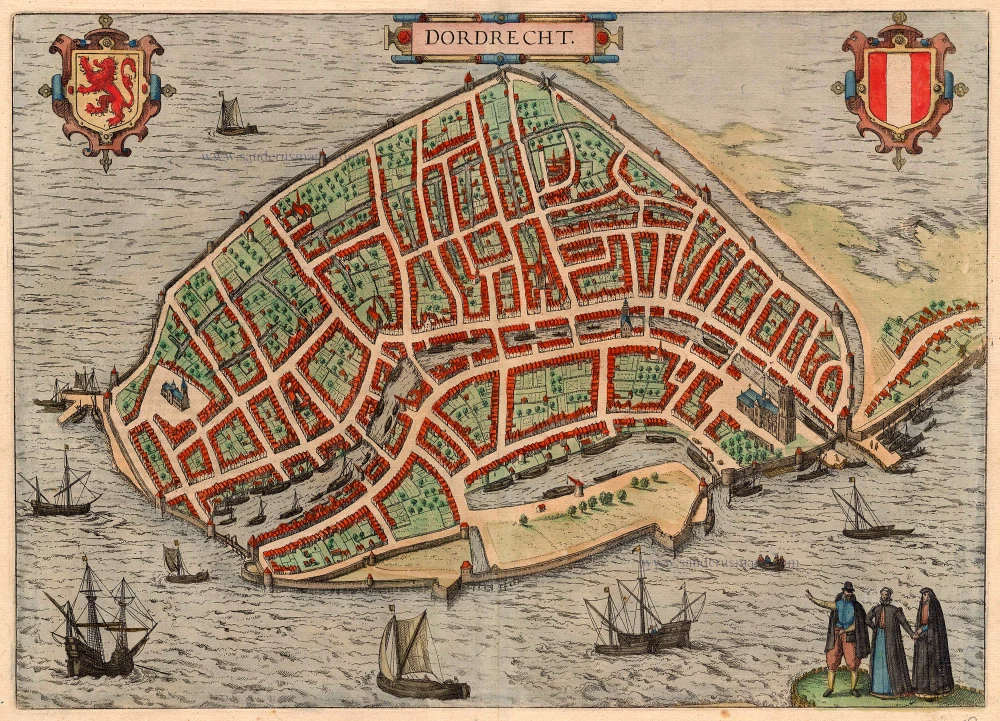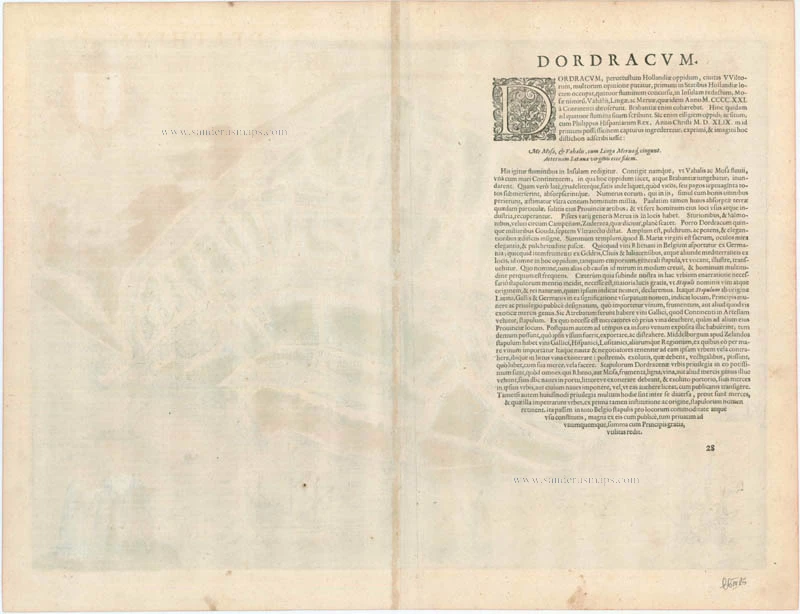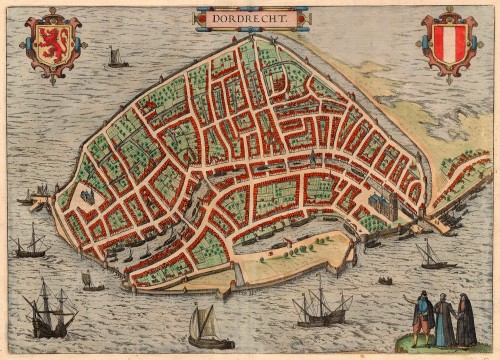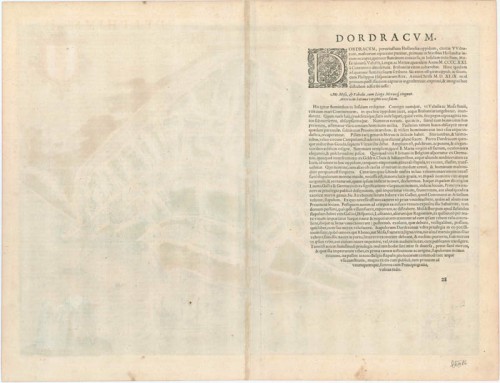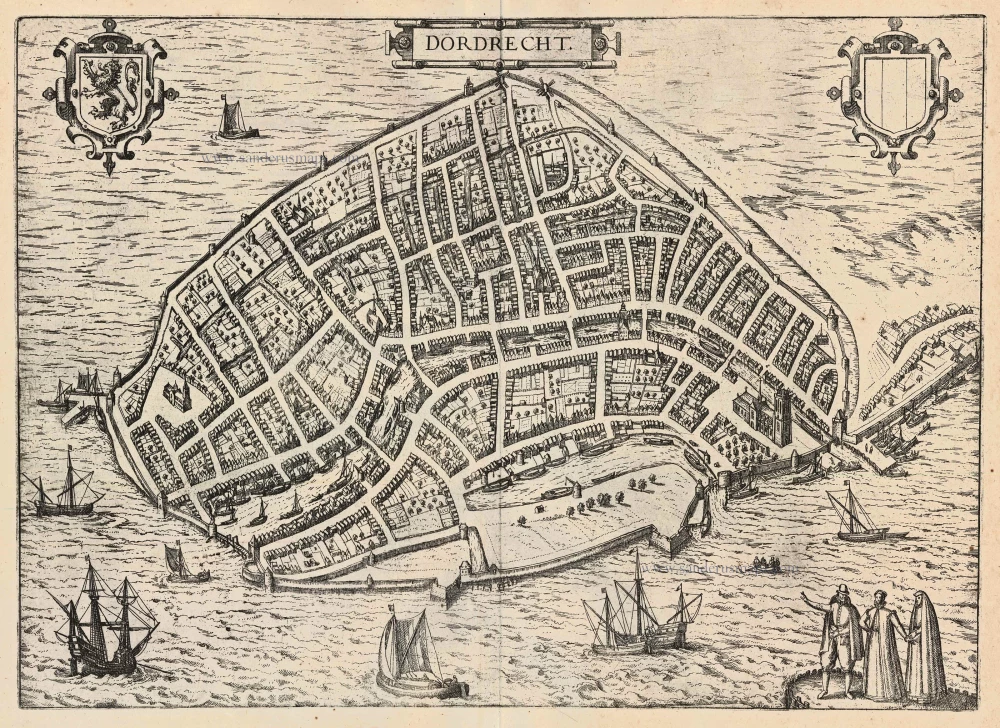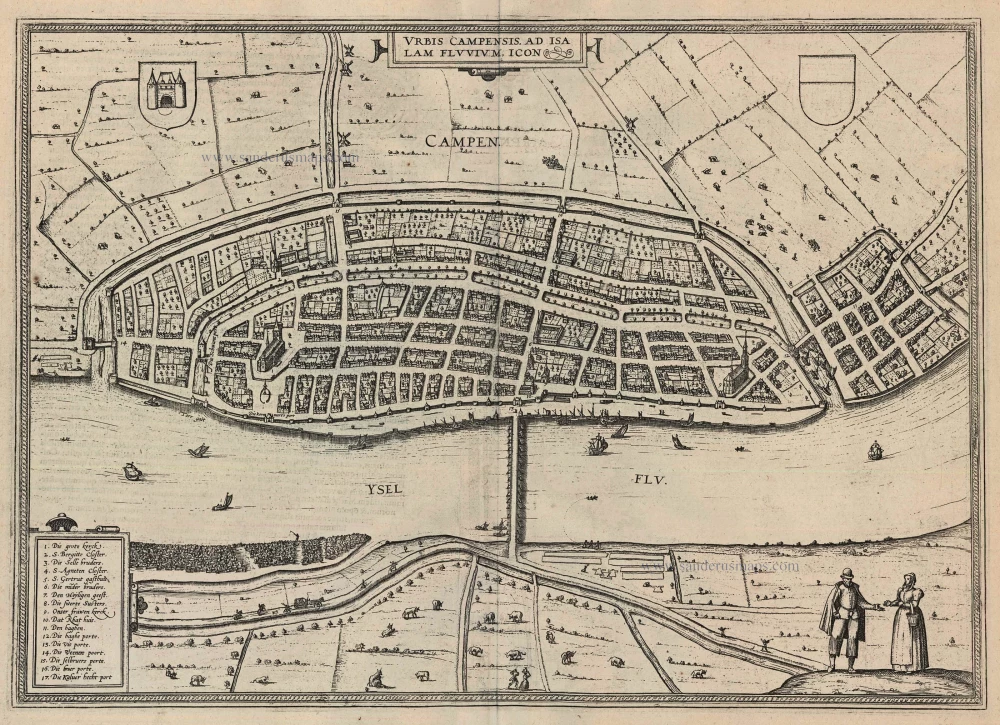Dordrecht by Braun and Hogenberg 1616
COMMENTARY BY BRAUN: "The cathedral, consecrated to Our Lady, is renowned for its beauty. All the Rhine wines that are exported from Germany to the Netherlands, as well as all the grain, come together in this city, which is an important city of trade and a famous stapulum. [...] Stapulum is taken from Latin and is used by the French and the Germans to mean a place that has been granted privileges by a prince and where one can import and trade in wine, cereals and other foreign wares."
This second engraving of Dordrecht offers a bird's-eye view of the important centre of trade. On the right, at the end of the canal that traverses the entire city, stands the Grote Kerk cathedral mentioned by Braun. The ships on the Merwekade underline Dordrecht's role as a river port. For many towns, in particular those on waterways or major trade routes, staple rights were the basis of their prosperity and thriving commercial activity.
Braun G. & Hogenberg F. and the Civitates Orbis Terrarum.
The Civitates Orbis Terrarum, or the "Braun & Hogenberg", is a six-volume town atlas and the most excellent book of town views and plans ever published: 363 engravings, sometimes beautifully coloured. It was one of the best-selling works in the last quarter of the 16th century. Georg Braun wrote the text accompanying the plans and views on the verso. Many plates were engraved after the original drawings of a professional artist, a professional artist, Joris Hoefnagel (1542-1600). The first volume was published in Latin in 1572, and the sixth in 1617. Frans Hogenberg created the tables for volumes I through IV, and Simon van den Neuwel made those for volumes V and VI. Other contributors were cartographers Daniel Freese and Heinrich Rantzau. Works by Jacob van Deventer, Sebastian Münster, and Johannes Stumpf were also used. Translations appeared in German and French.
Following the original publication of Volume 1 of the Civitates in 1572, seven further editions of 1575, 1577, 1582, 1588, 1593, 1599 and 1612 can be identified. Vol.2, first issued in 1575, was followed by further editions in 1597 and 1612. The subsequent volumes appeared in 1581, 1588, 1593, 1599 and 1606. The German translation of the first volume appeared from 1574 on, and the French edition from 1575 on.
Several printers were involved: Theodor Graminaeus, Heinrich von Aich, Gottfried von Kempen, Johannis Sinniger, Bertram Buchholtz and Peter von Brachel, who all worked in Cologne.
Georg Braun (1541-1622)
Georg Braun was born in Cologne in 1541. After his studies in Cologne, he entered the Jesuit Order as a novice. 1561, he obtained his bachelor's degree, and in 1562, he received his Magister Artium. Although he left the Jesuit Order, he studied theology, gaining a licentiate in theology.
Frans Hogenberg (1535-1590)
Frans Hogenberg was a Flemish and German painter, engraver, and mapmaker. He was born in Mechelen as the son of Nicolaas Hogenberg.
By the end of the 1560s, Frans Hogenberg was employed upon Abraham Ortelius's Theatrum Orbis Terrarum, published in 1570; he is named an engraver of numerous maps. In 1568, he was banned from Antwerp by the Duke of Alva and travelled to London, where he stayed a few years before emigrating to Cologne. He immediately embarked on his two most important works, the Civitates, published in 1572 and the Geschichtsblätter, which appeared in several series from 1569 until about 1587.
Thanks to large-scale projects like the Geschichtsblätter and the Civitates, Hogenberg's social circumstances improved with each passing year. He died as a wealthy man in Cologne in 1590.
Dordrecht
Item Number: 4158 Authenticity Guarantee
Category: Antique maps > Europe > The Netherlands - Cities
Antique map of Dordrecht by Braun and Hogenberg.
Title: Dordrecht
Date of the first edition: 1581.
Date of this map: 1616.
Copper engraving, printed on paper.
Size (not including margins): 335 x 465mm (13.19 x 18.31 inches).
Verso: Latin text.
Condition: Old coloured.
Condition Rating: A.
From: Civitates Orbis Terrarum. - Urbium Praeciuarum Totius Mundi Liber Tertius. Cologne, Petrus von Brachel, 1616. (Van der Krogt 4, 41:1.3)
COMMENTARY BY BRAUN: "The cathedral, consecrated to Our Lady, is renowned for its beauty. All the Rhine wines that are exported from Germany to the Netherlands, as well as all the grain, come together in this city, which is an important city of trade and a famous stapulum. [...] Stapulum is taken from Latin and is used by the French and the Germans to mean a place that has been granted privileges by a prince and where one can import and trade in wine, cereals and other foreign wares."
This second engraving of Dordrecht offers a bird's-eye view of the important centre of trade. On the right, at the end of the canal that traverses the entire city, stands the Grote Kerk cathedral mentioned by Braun. The ships on the Merwekade underline Dordrecht's role as a river port. For many towns, in particular those on waterways or major trade routes, staple rights were the basis of their prosperity and thriving commercial activity.
Braun G. & Hogenberg F. and the Civitates Orbis Terrarum.
The Civitates Orbis Terrarum, or the "Braun & Hogenberg", is a six-volume town atlas and the most excellent book of town views and plans ever published: 363 engravings, sometimes beautifully coloured. It was one of the best-selling works in the last quarter of the 16th century. Georg Braun wrote the text accompanying the plans and views on the verso. Many plates were engraved after the original drawings of a professional artist, a professional artist, Joris Hoefnagel (1542-1600). The first volume was published in Latin in 1572, and the sixth in 1617. Frans Hogenberg created the tables for volumes I through IV, and Simon van den Neuwel made those for volumes V and VI. Other contributors were cartographers Daniel Freese and Heinrich Rantzau. Works by Jacob van Deventer, Sebastian Münster, and Johannes Stumpf were also used. Translations appeared in German and French.
Following the original publication of Volume 1 of the Civitates in 1572, seven further editions of 1575, 1577, 1582, 1588, 1593, 1599 and 1612 can be identified. Vol.2, first issued in 1575, was followed by further editions in 1597 and 1612. The subsequent volumes appeared in 1581, 1588, 1593, 1599 and 1606. The German translation of the first volume appeared from 1574 on, and the French edition from 1575 on.
Several printers were involved: Theodor Graminaeus, Heinrich von Aich, Gottfried von Kempen, Johannis Sinniger, Bertram Buchholtz and Peter von Brachel, who all worked in Cologne.
Georg Braun (1541-1622)
Georg Braun was born in Cologne in 1541. After his studies in Cologne, he entered the Jesuit Order as a novice. 1561, he obtained his bachelor's degree, and in 1562, he received his Magister Artium. Although he left the Jesuit Order, he studied theology, gaining a licentiate in theology.
Frans Hogenberg (1535-1590)
Frans Hogenberg was a Flemish and German painter, engraver, and mapmaker. He was born in Mechelen as the son of Nicolaas Hogenberg.
By the end of the 1560s, Frans Hogenberg was employed upon Abraham Ortelius's Theatrum Orbis Terrarum, published in 1570; he is named an engraver of numerous maps. In 1568, he was banned from Antwerp by the Duke of Alva and travelled to London, where he stayed a few years before emigrating to Cologne. He immediately embarked on his two most important works, the Civitates, published in 1572 and the Geschichtsblätter, which appeared in several series from 1569 until about 1587.
Thanks to large-scale projects like the Geschichtsblätter and the Civitates, Hogenberg's social circumstances improved with each passing year. He died as a wealthy man in Cologne in 1590.

